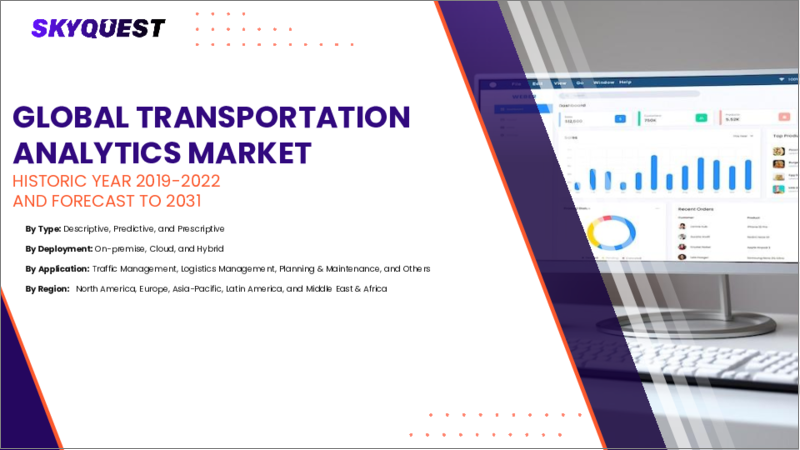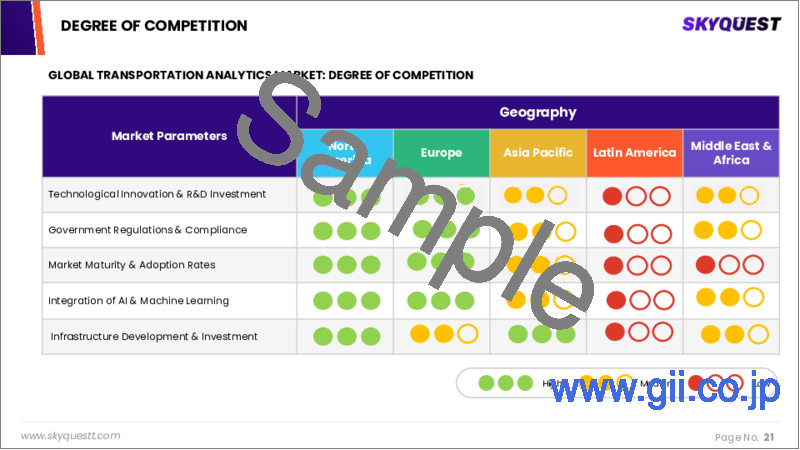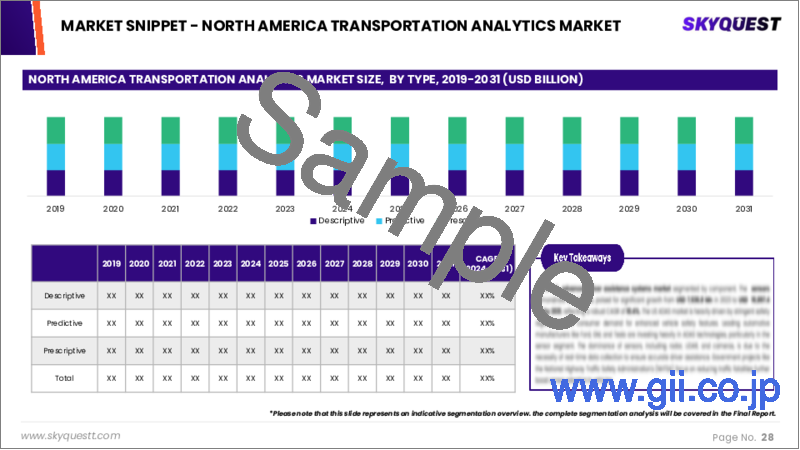|
|
市場調査レポート
商品コード
1588530
交通アナリティクスの市場規模、シェア、成長分析、タイプ別、展開別、モード別、地域別 - 産業予測、2024年~2031年Transportation Analytics Market Size, Share, Growth Analysis, By Type (Descriptive Analytics, Predictive Analytics), By Deployment (Cloud, On-Premises), By Mode (Roadways, Railways), By Region - Industry Forecast 2024-2031 |
||||||
|
|||||||
| 交通アナリティクスの市場規模、シェア、成長分析、タイプ別、展開別、モード別、地域別 - 産業予測、2024年~2031年 |
|
出版日: 2024年11月05日
発行: SkyQuest
ページ情報: 英文 265 Pages
納期: 3~5営業日
|
全表示
- 概要
- 目次
交通アナリティクスの世界市場規模は2022年に256億米ドルと評価され、2023年の311億6,000万米ドルから2031年には1,499億2,000万米ドルに成長し、予測期間中(2024-2031年)のCAGRは21.7%で推移する見通しです。
高度道路交通システム(ITS)市場は、特に新興国における交通渋滞と都市化の進展に後押しされ、大きく成長する見通しです。運輸研究所は、米国人が年間30億ガロン以上の燃料を消費し、毎年平均42時間を交通渋滞に費やしていることを明らかにし、効率的な交通管理ソリューションの緊急の必要性を強調しています。人口が増加し、都市が拡大するにつれて、交通アナリティクスに対する需要は増加し、市場の成長をさらに促進する可能性が高いです。米国運輸省が主要インフラ・プロジェクトに630億米ドル以上を投資したことに代表されるように、スマート・シティの開発を目指す政府の取り組みも、この拡大において重要な役割を果たすと思われます。さらに、乗用車と商用車の台数の増加は交通渋滞を悪化させるため、アナリティクスツールは交通の流れを最適化し、衝突を減らし、全体的な輸送効率を向上させるために不可欠なものとなっています。しかし、交通システムにおけるデータ分析への依存度が高まるにつれ、データのセキュリティとプライバシーに関する重大な懸念が生じる。全体として、米国交通アナリティクス市場は、スマート交通ソリューションへの技術的進歩と戦略的投資が原動力となって、今後数年間で持続的な成長を遂げると思われます。
目次
イントロダクション
- 調査の目的
- 定義
- 市場範囲
調査手法
- 情報調達
- 二次データソースと一次データソース
- 市場規模予測
- 市場の想定と制限
エグゼクティブサマリー
- 市場概要見通し
- 供給需要動向分析
- セグメント別機会分析
市場力学と見通し
- 市場力学
- 促進要因
- 機会
- 抑制要因
- 課題
- ポーターの分析
主な市場の考察
- 主な成功要因
- 競合の程度
- 主な投資機会
- 市場のエコシステム
- ケーススタディ分析
- 技術分析
- PESTEL分析
- マクロ経済要因
- 市場の魅力指数(2023年)
交通アナリティクス市場:タイプ別
- 市場概要
- 記述的分析
- 予測分析
- 処方的分析
交通アナリティクス市場:展開別
- 市場概要
- クラウド
- オンプレミス
- ハイブリッド
交通アナリティクス市場:モード別
- 市場概要
- 道路
- 道路安全管理
- 道路交通管理
- 道路におけるその他の用途
- 鉄道
- パフォーマンス管理
- 鉄道交通管理
- 鉄道におけるその他の用途
- 航空
- 航空交通管理
- ルート最適化
- 航空におけるその他の用途
- 水路
- 船舶監視
- ルート最適化
- 水路におけるその他の用途
交通アナリティクス市場:地域別
- 市場概要
- 北米
- 米国
- カナダ
- 欧州
- ドイツ
- スペイン
- フランス
- 英国
- イタリア
- その他欧州地域
- アジア太平洋地域
- 中国
- インド
- 日本
- 韓国
- その他アジア太平洋地域
- ラテンアメリカ
- ブラジル
- その他ラテンアメリカ地域
- 中東・アフリカ(MEA)
- GCC諸国
- 南アフリカ
- その他中東・アフリカ地域
競合情勢
- 上位5社の比較
- 主要企業の市場ポジショニング(2023年)
- 主な市場企業が採用した戦略
- 市場における最近の活動
- 主要企業の市場シェア(2023年)
主要企業プロファイル
- IBM(US)
- Siemens(Germany)
- Cubic(US)
- Cellint(Israel)
- Alteryx(US)
- Kapsch Trafficcom(Austria)
- INRIX(US)
- Indra Sistemas(Spain)
- Trimble(US)
- TomTom(Netherlands)
- Iteris(US)
- Conduent(US)
- Hitachi(Japan)
- Thales Group(France)
- OmniTracs(US)
- Techvantagee(US)
- CARTO(Spain)
- Syntelic(US)
- SmartDrive Systems(US)
- Envista(US)
Global Transportation Analytics Market size was valued at USD 25.6 billion in 2022 and is poised to grow from USD 31.16 billion in 2023 to USD 149.92 billion by 2031, growing at a CAGR of 21.7% during the forecast period (2024-2031).
The Intelligent Transportation Systems (ITS) market is poised for significant growth, fueled by increasing traffic congestion and urbanization, particularly in emerging economies. The Transportation Institute highlights that Americans burn over 3 billion gallons of fuel annually and spend an average of 42 hours in traffic each year, underlining the urgent need for efficient traffic management solutions. As populations swell and cities expand, the demand for transportation analytics will likely rise, further driving market growth. Government initiatives aimed at developing smart cities, exemplified by the US Department of Transportation's investment of over USD 63 billion in major infrastructure projects, will also play a crucial role in this expansion. Additionally, the rise in both passenger and commercial vehicle numbers exacerbates traffic congestion, making analytics tools essential for optimizing traffic flow, reducing collisions, and improving overall transportation efficiency. However, the growing reliance on data analytics in transportation systems raises critical concerns regarding data security and privacy, which companies must address to gain consumer trust and compliance. Overall, the US Transportation Analytics Market is set to experience sustainable growth in the coming years, driven by technological advancements and strategic investments in smart transportation solutions.
Top-down and bottom-up approaches were used to estimate and validate the size of the Global Transportation Analytics market and to estimate the size of various other dependent submarkets. The research methodology used to estimate the market size includes the following details: The key players in the market were identified through secondary research, and their market shares in the respective regions were determined through primary and secondary research. This entire procedure includes the study of the annual and financial reports of the top market players and extensive interviews for key insights from industry leaders such as CEOs, VPs, directors, and marketing executives. All percentage shares split, and breakdowns were determined using secondary sources and verified through Primary sources. All possible parameters that affect the markets covered in this research study have been accounted for, viewed in extensive detail, verified through primary research, and analyzed to get the final quantitative and qualitative data.
Global Transportation Analytics Market Segmental Analysis
Global Transportation Analytics Market is segmented by Type, Deployemnt, Mode, and Region. Based on Type, the market is segmented into Descriptive Analytics, Predictive Analytics, and Prescriptive Analytics. Based on Deployment, the market is segmented into Cloud, On-Premises, and Hybrid. Based on Mode, the market is segmented into Roadways, Railways, Airways, Waterways. Based on region, the market is segmented into North America, Europe, Asia Pacific, Latin America and Middle East & and Africa.
Driver of the Global Transportation Analytics Market
The Global Transportation Analytics market is significantly driven by the increasing deployment of advanced traffic management systems (ATMs) and smart transportation initiatives worldwide. These analytics tools enhance efficiency by minimizing fuel consumption, reducing air pollution, and decreasing travel times, leading to heightened demand for such solutions. The trend toward operational automation further fuels this market expansion, as innovative technologies like artificial intelligence (AI) and machine learning (ML) are deployed to optimize transportation processes. Complementing this growth are government initiatives aimed at developing smart cities, which integrate transportation analytics with intelligent systems. Factors like urbanization, evolving lifestyles, increased investments, and rising consumer spending also contribute to the robust growth of this market.
Restraints in the Global Transportation Analytics Market
The Global Transportation Analytics market is poised for growth; however, it faces significant restraints that may inhibit expansion. Chief among these is the challenge of recouping return on investment (ROI) from outdated systems, which can deter organizations from adopting advanced analytics solutions. Additionally, stringent transportation regulatory standards complicate implementation efforts, posing further risks. The complexity of transporting diverse commodities and the integration challenges associated with legacy systems add another layer of difficulty, which could stifle innovation and slow the adoption of new analytics technologies in the sector between 2023 and 2030, ultimately impacting market growth trajectories.
Market Trends of the Global Transportation Analytics Market
The Global Transportation Analytics market is witnessing significant growth, driven by advancements in smart transportation infrastructure and the integration of AI and machine learning technologies. As electronic access and mobility management solutions proliferate, demand for analytics that monitor and optimize transportation systems is surging. Innovations like AI-powered real-time passenger density data collection enhance operational efficiency and traveler experience. The push toward greener mobility solutions further accelerates market expansion by promoting automated processes and reducing congestion. Consequently, the sector is capitalizing on increased awareness among travelers regarding system management and streamlined journey planning, signaling a robust trend towards smarter, safer transportation solutions.
Table of Contents
Introduction
- Objectives of the Study
- Definitions
- Market Scope
Research Methodology
- Information Procurement
- Secondary & Primary Data Sources
- Market Size Estimation
- Market Assumptions & Limitations
Executive Summary
- Market Overview Outlook
- Supply Demand Trend Analysis
- Segmental Opportunity Analysis
Market Dynamics & Outlook
- Market Dynamics
- Drivers
- Opportunities
- Restraints
- Challenges
- Porters Analysis
- Competitive rivalry
- Threat of Substitute Products
- Bargaining Power of Buyers
- Threat of New Entrants
- Bargaining Power of Suppliers
Key Market Insights
- Key Success Factor
- Degree of Competition
- Top Investment Pockets
- Ecosystem of the Market
- Case Study Analysis
- Technology Analysis
- PESTEL Analysis
- Macro-Economic Factors
- Market Attractiveness Index, 2023
Transportation Analytics Market by Type
- Market Overview
- Descriptive Analytics
- Predictive Analytics
- Prescriptive Analytics
Transportation Analytics Market by Deployment
- Market Overview
- Cloud
- On-Premises
- Hybrid
Transportation Analytics Market by Mode
- Market Overview
- Roadways
- Road Safety Management
- Road Traffic Management
- Other Applications in Roadways
- Railways
- Performance Management
- Rail Traffic Management
- Other Applications in Railways
- Airways
- Air Traffic Management
- Route Optimization
- Other Applications in Airways
- Waterways
- Ship Monitoring
- Route Optimization
- Other Applications in Waterways
Transportation Analytics Market Size by Region
- Market Overview
- North America
- USA
- Canada
- Europe
- Germany
- Spain
- France
- UK
- Italy
- Rest of Europe
- Asia Pacific
- China
- India
- Japan
- South Korea
- Rest of Asia-Pacific
- Latin America
- Brazil
- Rest of Latin America
- Middle East & Africa (MEA)
- GCC Countries
- South Africa
- Rest of MEA
Competitive Landscape
- Top 5 Player Comparison
- Market Positioning of Key Players, 2023
- Strategies Adopted by Key Market Players
- Recent Activities in the Market
- Key Companies Market Share (%), 2023
Key Company Profiles
- IBM (US)
- Company Overview
- Business Segment Overview
- Financial Updates
- Key Developments
- Siemens (Germany)
- Company Overview
- Business Segment Overview
- Financial Updates
- Key Developments
- Cubic (US)
- Company Overview
- Business Segment Overview
- Financial Updates
- Key Developments
- Cellint (Israel)
- Company Overview
- Business Segment Overview
- Financial Updates
- Key Developments
- Alteryx (US)
- Company Overview
- Business Segment Overview
- Financial Updates
- Key Developments
- Kapsch Trafficcom (Austria)
- Company Overview
- Business Segment Overview
- Financial Updates
- Key Developments
- INRIX (US)
- Company Overview
- Business Segment Overview
- Financial Updates
- Key Developments
- Indra Sistemas (Spain)
- Company Overview
- Business Segment Overview
- Financial Updates
- Key Developments
- Trimble (US)
- Company Overview
- Business Segment Overview
- Financial Updates
- Key Developments
- TomTom (Netherlands)
- Company Overview
- Business Segment Overview
- Financial Updates
- Key Developments
- Iteris (US)
- Company Overview
- Business Segment Overview
- Financial Updates
- Key Developments
- Conduent (US)
- Company Overview
- Business Segment Overview
- Financial Updates
- Key Developments
- Hitachi (Japan)
- Company Overview
- Business Segment Overview
- Financial Updates
- Key Developments
- Thales Group (France)
- Company Overview
- Business Segment Overview
- Financial Updates
- Key Developments
- OmniTracs (US)
- Company Overview
- Business Segment Overview
- Financial Updates
- Key Developments
- Techvantagee (US)
- Company Overview
- Business Segment Overview
- Financial Updates
- Key Developments
- CARTO (Spain)
- Company Overview
- Business Segment Overview
- Financial Updates
- Key Developments
- Syntelic (US)
- Company Overview
- Business Segment Overview
- Financial Updates
- Key Developments
- SmartDrive Systems (US)
- Company Overview
- Business Segment Overview
- Financial Updates
- Key Developments
- Envista (US)
- Company Overview
- Business Segment Overview
- Financial Updates
- Key Developments





